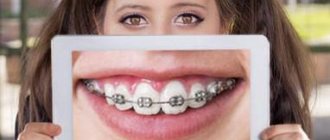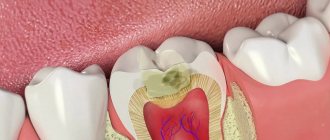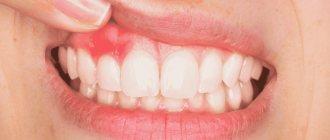Pain after caries treatment: normal or pathological?
Pain after treatment and filling does not always indicate pathology. In 70% of cases, it is the norm, especially if you come to the doctor with advanced, deep caries, progressing or developing into pulpitis.
Mild pain traditionally occurs due to mechanical irritation of the treated tooth - biting on it, chewing hard food, pressing with a finger or a toothpick. This is due to the close fit of the bottom of the carious cavity to the pulp and nerve of the tooth. When you press on the coronal part, the filling puts even more intense pressure on the pulp, which provokes pain. Normally, they are not too pronounced and rather resemble a dull “bone” pain.
There is no need to worry about such pain - over time, your health will definitely return to normal, and the tooth will stop bothering you even with pressure or irritation. Neutralization of uncomfortable sensations is associated with the production of a protective layer of dentin by the pulp, which, as it were, “distances” it from the base of the filling. This process may take up to 2 months.
The first cause for concern is the manifestation of nagging or acute but constant pain, which does not depend on external factors.
Toothache cannot be tolerated. “Muffling” it with strong analgesics is also not recommended, especially if the nature of the symptom is unknown to you.
Leave your phone number. The clinic administrator will call you back.
By leaving a request on the site, you consent to the processing of personal data
Make an appointment
Initial consultation with a dentist
For free!
After filling the cervical part of the tooth (the one located at the junction with the gum), a transient increase in sensitivity is likely. Your tooth can react to cold and hot, as well as sweet and sour. Pay attention to the presence of a “step” or depression between the base of the filling and the original tooth tissue. If you notice an unevenness on the surface, contact your dentist immediately, as this may subsequently lead to inflammation or exposure of the root.
Another variant of the norm may be pain that occurs against the background of:
- Individual response to treatment of dental caries (especially drilling, grinding and polishing);
- X-raying the tooth with special equipment;
- Irritation of soft tissues due to the need to drill out a deep cavity (usually with pulpitis).
Discomfortable sensations go away on their own after 1-8 weeks, depending on the original problem and the individual characteristics of the body.
Increased sensitivity of teeth during deep stages of caries
Caries develops gradually - at first, a person may not even suspect that he has this problem if he does not practice regular dental examinations. There are four stages of the carious process:
- the so-called “chalk stain”, when the enamel changes color and acquires a darker shade - grayish or milky;
- superficial: teeth begin to react to hot, cold, sour, etc., the stain becomes rough;
- medium caries, when carious cavities increasingly destroy dentin, and pain occurs more often and is felt more strongly;
- deep: the carious process begins to affect the pulp, a cavity is formed bordering the dental nerve.
If caries is not treated, its complications are inevitable, for example, pulpitis, periodontitis, and as a result, teeth can simply be lost.
When is there a reason to worry?
Sometimes doctors recommend that their patients take painkillers after treatment, as they objectively assess the complexity and assume temporary side effects. But symptom relief does not take longer than 3-4 days even after tooth extraction. You must understand that pain is not an enemy at all, but a benefit that signals a problem. And if it appears on an ongoing basis for a week or more, this is a good reason to visit a specialist.
Pay close attention to any accompanying symptoms:
- Fever or slight but constant increase in temperature;
- Bleeding gums around the treated tooth;
- Acute attacks that occur at night;
- A significant increase in sensitivity, encouraging you to completely abandon potential irritants in the form of ice cream or hot tea;
- Numbness of the soft tissues of the jaw at the site of the procedures;
- Darkening or blueness of the gums;
- General malaise and weakness without objective reasons.
Constant aching pain with periodic exacerbations can be associated with overdrying or underdrying of the formed cavity before filling. Both mistakes by the doctor are fraught with complications. When overdrying, persistent irritation of nerve endings can occur, leading to death. If it is not dried enough, the adhesive (sticky material) cannot be absorbed into the dentin, and when the filling shrinks, it comes off from the bottom of the cavity, creating a discharged space here like a vacuum. This also irritates the nerve endings (in professional language the phenomenon is called “debonding”).
In both cases, there is no point in enduring pain for more than a week. Perhaps after 7 days it will really stop bothering you, and the reason for going to the dentist will disappear by itself. But if a week after treatment has passed and the symptom persists, you should immediately visit a doctor.
How to relieve toothache yourself?
- If pain occurs, the right solution would be to take special painkillers. Dentists advise their patients Nurofen, Ketanov, Dexalgin, Baralgin. You can also take regular analgin in tablets. Specialists at Dr. Granov's clinic strongly recommend that you stop taking aspirin and medications containing high concentrations of acetylsalicylic acid. The analgesic effect from them is small, but in high dosages the substance provokes complications, sometimes very dangerous for general health.
- Temporarily stop chewing food on the affected side. Perhaps the symptom is associated specifically with biting - that is, mechanical irritation.
- Under no circumstances use “grandmother’s methods” in the form of heating, lotions or compresses. The procedure can significantly aggravate the current situation and even obviously complicate the process of subsequent treatment, if necessary.
- Antibiotics should not be taken without a doctor's prescription. The selection of antibacterial drugs is a responsible step in which the doctor carefully weighs the benefits and risks. Unauthorized use of antibiotics can lead to unpredictable consequences.
- You can purchase a natural product at the pharmacy - dental drops. It contains plant extracts of valerian, mint and camphor. Soak a tight cotton swab in the solution and apply it to the sore tooth. Change the tampon every 10 minutes until pain subsides.
- You can help yourself by rinsing with decoctions of soothing herbs: mint, lemon balm, chamomile.
Methods of dental treatment for caries
The method of treating this disease depends on its stage. Let's take a closer look at what measures are applied at each stage:
- Chalk stain. In this case, it is still possible to carry out therapy without resorting to a drill and filling. Typically, enamel remineralization is carried out using formulations with a high content of sodium fluoride and calcium gluconate.
- At the superficial stage, it may sometimes be necessary to install fillings, and remineralization of the enamel is also carried out.
- In the middle stage, it is necessary to clean carious cavities and then fill them to protect them from bacteria.
- Deep caries is treated in several stages. First, the damaged dental structures are cleaned, then a temporary filling is installed. On the second visit, if no negative reactions occur, the doctor puts a permanent filling, grinds and polishes the tooth.
A competent dentist will try to preserve the patient’s teeth while treatment is possible. He will use the removal of carious units only at such a degree of destruction of dental structures that it is no longer possible to save them.
In what cases is it important to visit a doctor?
Visit a specialist urgently if you have:
- Acute toothache;
- Pain combined with bleeding gums;
- Dull pain that sharply worsens when eating cold or hot food (this may indicate untreated chronic pulpitis);
- The temperature has risen;
- Discharge from the gums or changes in the gum tissue are observed.
If you don't trust the dentist who treated your tooth before symptoms began, find a better professional. The specialists at Dr. Granov’s clinic are ready to help you with dental treatment and correct the mistakes of others.
We are responsible for the health of our patients and choose progressive, safe, effective treatment methods.
Diagnosis and treatment
Diagnosis of increased tooth sensitivity after installation of a filling includes:
- probing,
- electroodontometry.
Based on the results of the examination and examination, the doctor chooses treatment tactics.
- Fluoridation of teeth. Reduces sensitivity and enriches enamel with beneficial substances.
- Use of desensitizing paste and fluoride-containing rinses for oral care. With regular use of such products, teeth become less sensitive.
If the cause of hyperesthesia is non-compliance with filling rules, and the problem cannot be solved by conservative methods, repeated dental treatment is performed.
Relief from pain
If this symptom bothers you greatly or is accompanied by edema or swelling, then contact your dentist. Experienced doctors at the Aurora Star clinic will quickly identify the cause of pain and make every effort to eliminate it. Sometimes this requires simply filling the tooth again (for example, if it was underfilled or overfilled). If complications occur, such as periodontitis, then surgical treatment will be required - an incision to remove pus.
Sometimes pain is a natural phenomenon after treatment for dental diseases. But everyone has their own pain threshold. If this symptom bothers you greatly, your doctor will help you choose the appropriate painkillers. At the Aurora Star clinic you can get rid of the consequences of poor-quality dental treatment, and at the same time, pain. Experienced dentists, modern equipment and a pleasant pricing policy await you.
Allergic pain reactions
In rare cases, the injected filling materials can cause an allergic reaction in the patient, which then causes toothache. Such allergies are very rare today, since holes are rarely filled with amalgam (the professional name for one of the filling materials whose properties take advantage of the ability of mercury to dissolve certain metals), but rather with modern light-curing composite filling materials.
How to relieve pain
Even mild pain can cause many problems. They are distracting and annoying, so it’s only logical to take steps to eliminate them.
Important: we are talking about pain, which is a consequence of the treatment of deep caries and is not a symptom of complications. You can reduce it and at the same time speed up the tissue healing process in the following ways:
- taking painkillers;
- rinsing the mouth with a soda-saline solution;
- rinsing and bathing with a decoction of sage and chamomile;
- temporary removal of hot and cold foods from the diet;
- refusal of spicy, sour, and also too hard foods;
- avoiding too much stress on the tooth;
- quitting smoking and alcohol.
If the treatment procedure was carried out correctly, the pain will begin to subside on the third day and completely disappear on the fifth day.
If your tooth hurts after root canal filling
Unlike classic filling, root canal treatment is a procedure that essentially kills the tooth and its tissues. Of course, after such manipulations, pain in the first few days is quite common (this is related to the question of whether a tooth should hurt after root canal filling). However, if a tooth hurts a week after filling, then this is a good enough reason to start worrying. Pain after root canal filling can be caused by a number of reasons, but in any case you should not think that everything will go away on its own. Negligence in relation to one's own health can lead to periodontitis, damage to bone tissue and even death caused by infection of the body. So, in popular parlance, when your nerve hurts after filling a tooth, you have serious cause for concern.
Why does a tooth hurt after root canal filling?
| Type of complication | Description | Pain symptoms |
| Root perforation | As a rule, this happens when installing a pin into root canals, when its tip breaks through the root walls and rests on the bone tissue. The patient requires quite complex rehabilitation, otherwise there is a high probability of developing an infection. | Severe aching pain that can extend beyond the tooth. |
| Underfilling | A cavity remains in the root canals, which is not filled with filling material. This can lead to inflammation and abscesses. | A slight aching pain in the early stages and a strong (sometimes throbbing) pain as complications develop. Often after filling a tooth, the gums hurt. |
| Resealing | The material is planted too deep beyond the root tip. If its amount is insignificant, then over time it can resolve on its own. In more serious situations, resection of the root apex is required. | Prolonged aching pain up to neuralgia. |
| Fragments of tools in channels | A common medical mistake is when a piece of instrument remains inside the root canals. | From aching to sharp piercing pain when biting. If, after canal filling, it hurts to press on a tooth, this may also be one of the characteristic signs. |
When, after removing the nerve and filling, the tooth hurts during the first two to three days and the pain is pronounced, tell your dentist about it. In some cases, a quick response to the problem will help avoid serious complications.









